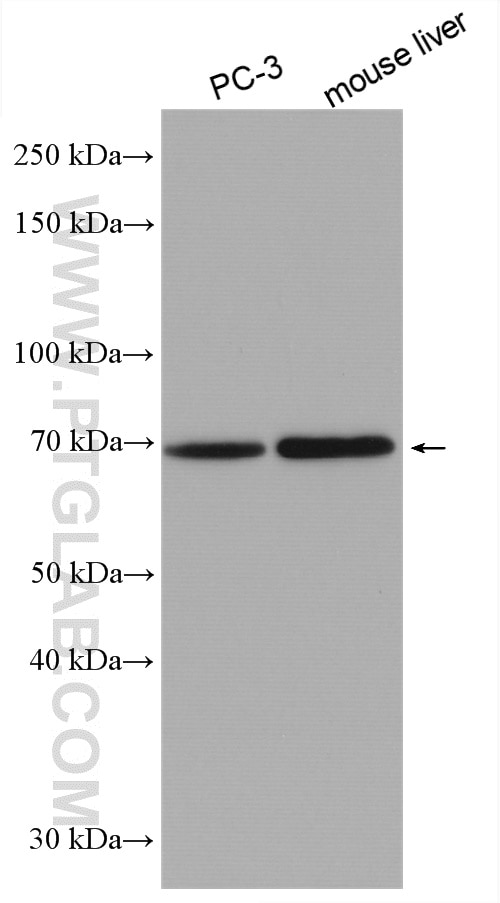- Phare
- Validé par KD/KO
Anticorps Polyclonal de lapin anti-HAS3
HAS3 Polyclonal Antibody for WB, IHC, ELISA
Hôte / Isotype
Lapin / IgG
Réactivité testée
Humain, rat, souris
Applications
WB, FC, IHC, ELISA
Conjugaison
Non conjugué
N° de cat : 15609-1-AP
Synonymes
Galerie de données de validation
Applications testées
| Résultats positifs en WB | cellules PC-3, cellules L02, tissu hépatique de souris |
| Résultats positifs en IHC | tissu de cancer du foie humain il est suggéré de démasquer l'antigène avec un tampon de TE buffer pH 9.0; (*) À défaut, 'le démasquage de l'antigène peut être 'effectué avec un tampon citrate pH 6,0. |
Dilution recommandée
| Application | Dilution |
|---|---|
| Western Blot (WB) | WB : 1:500-1:1000 |
| Immunohistochimie (IHC) | IHC : 1:100-1:400 |
| It is recommended that this reagent should be titrated in each testing system to obtain optimal results. | |
| Sample-dependent, check data in validation data gallery | |
Applications publiées
| KD/KO | See 1 publications below |
| WB | See 6 publications below |
| IHC | See 3 publications below |
| FC | See 1 publications below |
Informations sur le produit
15609-1-AP cible HAS3 dans les applications de WB, FC, IHC, ELISA et montre une réactivité avec des échantillons Humain, rat, souris
| Réactivité | Humain, rat, souris |
| Réactivité citée | Humain, souris |
| Hôte / Isotype | Lapin / IgG |
| Clonalité | Polyclonal |
| Type | Anticorps |
| Immunogène | HAS3 Protéine recombinante Ag7999 |
| Nom complet | hyaluronan synthase 3 |
| Masse moléculaire calculée | 63 kDa |
| Poids moléculaire observé | 63 kDa |
| Numéro d’acquisition GenBank | BC021853 |
| Symbole du gène | HAS3 |
| Identification du gène (NCBI) | 3038 |
| Conjugaison | Non conjugué |
| Forme | Liquide |
| Méthode de purification | Purification par affinité contre l'antigène |
| Tampon de stockage | PBS avec azoture de sodium à 0,02 % et glycérol à 50 % pH 7,3 |
| Conditions de stockage | Stocker à -20°C. Stable pendant un an après l'expédition. L'aliquotage n'est pas nécessaire pour le stockage à -20oC Les 20ul contiennent 0,1% de BSA. |
Informations générales
HAS3(hyaluronan synthase 3) belongs to the NodC/HAS family, which are widely expressed in human tissues and appear to function in embryogenesis, wound healing and other processes associated with cellular proliferation and migration(PMID:14566823). HAS3 is involved in the synthesis of the unbranched glycosaminoglycan hyaluronan, or hyaluronic acid, which is a major constituent of the extracellular matrix. It may play a role in the progression of colon cancer and, as such, may provide novel targets for diagnostic and therapeutic interventions(PMID:14566823). It has 2 isoforms produced by alternative splicing and the protein has a glycosylation site.
Protocole
| Product Specific Protocols | |
|---|---|
| WB protocol for HAS3 antibody 15609-1-AP | Download protocol |
| IHC protocol for HAS3 antibody 15609-1-AP | Download protocol |
| Standard Protocols | |
|---|---|
| Click here to view our Standard Protocols |
Publications
| Species | Application | Title |
|---|---|---|
J Pineal Res Melatonin inhibits the stemness of head and neck squamous cell carcinoma by modulating HA synthesis via the FOSL1/HAS3 axis | ||
Int J Mol Sci Elevation of Hyaluronan Synthase by Magnesium Supplementation Mediated through the Activation of GSK3 and CREB in Human Keratinocyte-Derived HaCaT Cells. | ||
Cancers (Basel) C1q-HA Matrix Regulates the Local Synthesis of Hyaluronan in Malignant Pleural Mesothelioma by Modulating HAS3 Expression. | ||
Mol Med Rep miR‑29a‑3p represses proliferation and metastasis of gastric cancer cells via attenuating HAS3 levels.
|






